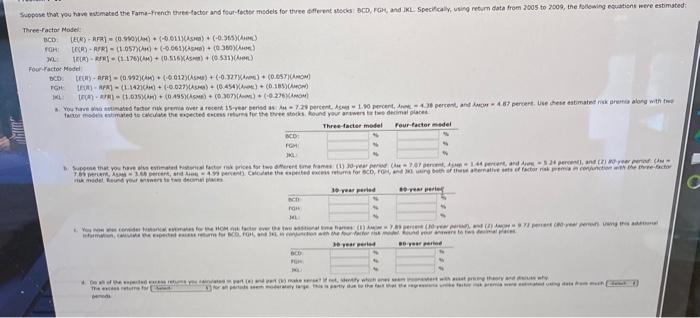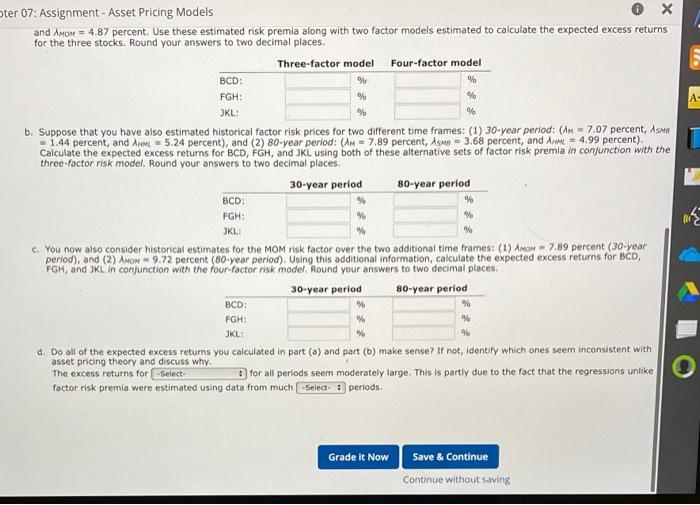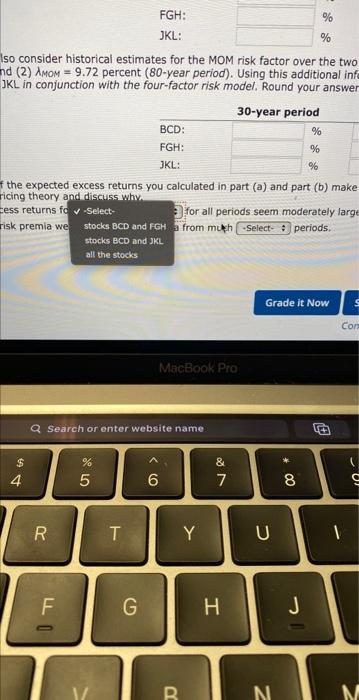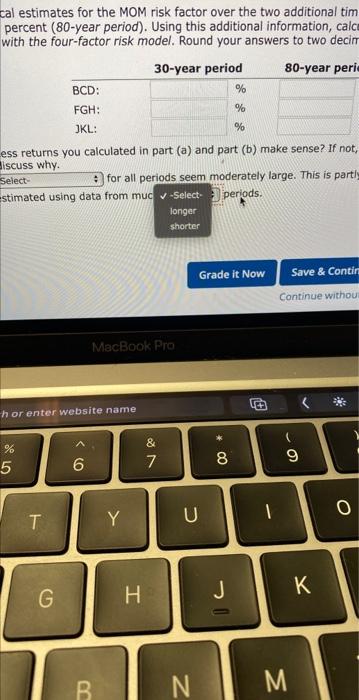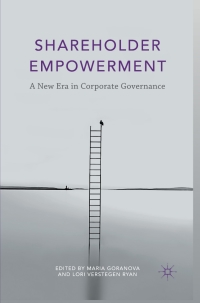Ture-factar Model. Suppose that you have estimated the Fama-French three-factor and four-factor models for three different stocks: BCD, FGH, and JKL. Specifically. using return data from 2005 to 2009 , the following equations were estimated: Three-Factor Model: BCD:FGH:JKL:[E(R)RFR]=(0.990)(M)+(0.011)(sMs)+(0.365)(HML)[E(R)RFR]=(1.057)(M)+(0.061)(sMeE)+(0.380)(mimL)[E(R)RFR]=(1.176)(M)+(0.516)(sMO)+(0.531)(HML) Four-Factor Model: BCD:[E(R)RFR]=(0.992)(M)+(0.012)(sme)+(0.327)(MM)+(0.057)(HroM)FGH:[E(R)RFR]=(1.142)(M)+(0.027)(sms)+(0.454)(tim)+(0.185)(mom)JKL:[E(R)RFR]=(1.035)(M)+(0.495)(SMo)+(0.307)(Hem)+(0.276)(moM) a. You have also estimated factor risk premia over a recent 15-year period as: M=7.29 percent, sme =1.90 percent, mic =4.38 percent, and dmou =4.87 percent. Use these estimated risk premia along with two factor models estimated to calculate the expected excess return for the three stocks. Round your answers to two decimal places. b. Suppose that you have also estimated historical factor risk prices for two different time frames: (1) 30-year period: ( A - =7.07 percent, Asu Calculate the expected excess returns for BCD, FGH, and JKL using both of these alternative sets of factor risk premia in conjunction with th three-factor risk model. Round your answers to two decimal places. c. You now also consider historical estimates for the MOM risk factor over the two additional time frames: (1) . Arom = 7.89 percent ( 30 -year period), and (2) Auos =9.72 percent (80-year period). Using this additional information, calculate the expected excess returns for BCD. FGH, and JKL in confunction with the four-foctor risk model. Round your answers to two decimal places. 07: Assignment-Asset Pricing Models and mom =4.87 percent. Use these estimated risk premia along with two factor models estimated to calculate the expected excess returns for the three stocks. Round your answers to two decimal places. b. Suppose that you have also estimated historical factor risk prices for two different time frames: (1) 30 -year period: ( AM=7.07 percent, Asme = 1.44 percent, and Am=5.24 percent), and (2) 80 -year period: (M=7.89 percent, s=3.68 percent, and sm=4.99 percent). Calculate the expected excess returns for BCD, FGH, and JKL using both of these alternative sets of factor risk premia in conjunction with the three-factor risk model. Round your answers to two decimal places. c. You now also consider historical estimates for the MOM risk factor over the two additional time frames: (1) Amou = 7.89 percent (30-year period), and (2) dwow =9.72 percent ( 80 -year period). Using this additional information, calculate the expected excess returns for BCD, FGH, and JKL in conjunction with the four-factor risk model, Round your answers to two decimal places. d. Do all of the expected excess returns you calculated in part (a) and part (b) make sense? If not, identify which ones seem inconsistent with asset pricing theory and discuss why. The excess returns for for all periods seem moderately large. This is partly due to the foct that the regressions unlike factor risk premia were estimated using data from much periods. Iso consider historical estimates for the MOM risk factor over the two nd (2)mom=9.72 percent (80-year period ). Using this additional inf JKL in conjunction with the four-factor risk model. Round your answer the expected excess returns you calculated in part (a) and part (b) make ricing theory and discuss whv. cess returns fo for all periods seem moderately large from mukh periods. cal estimates for the MOM risk factor over the two additional tim percent (80-year period). Using this additional information, calc with the four-factor risk model. Round your answers to two decim ess returns you calculated in part (a) and part (b) make sense? If not, liscuss why. | for all periods seem moderately large. This is partl] istimated using data from mur periods. Ture-factar Model. Suppose that you have estimated the Fama-French three-factor and four-factor models for three different stocks: BCD, FGH, and JKL. Specifically. using return data from 2005 to 2009 , the following equations were estimated: Three-Factor Model: BCD:FGH:JKL:[E(R)RFR]=(0.990)(M)+(0.011)(sMs)+(0.365)(HML)[E(R)RFR]=(1.057)(M)+(0.061)(sMeE)+(0.380)(mimL)[E(R)RFR]=(1.176)(M)+(0.516)(sMO)+(0.531)(HML) Four-Factor Model: BCD:[E(R)RFR]=(0.992)(M)+(0.012)(sme)+(0.327)(MM)+(0.057)(HroM)FGH:[E(R)RFR]=(1.142)(M)+(0.027)(sms)+(0.454)(tim)+(0.185)(mom)JKL:[E(R)RFR]=(1.035)(M)+(0.495)(SMo)+(0.307)(Hem)+(0.276)(moM) a. You have also estimated factor risk premia over a recent 15-year period as: M=7.29 percent, sme =1.90 percent, mic =4.38 percent, and dmou =4.87 percent. Use these estimated risk premia along with two factor models estimated to calculate the expected excess return for the three stocks. Round your answers to two decimal places. b. Suppose that you have also estimated historical factor risk prices for two different time frames: (1) 30-year period: ( A - =7.07 percent, Asu Calculate the expected excess returns for BCD, FGH, and JKL using both of these alternative sets of factor risk premia in conjunction with th three-factor risk model. Round your answers to two decimal places. c. You now also consider historical estimates for the MOM risk factor over the two additional time frames: (1) . Arom = 7.89 percent ( 30 -year period), and (2) Auos =9.72 percent (80-year period). Using this additional information, calculate the expected excess returns for BCD. FGH, and JKL in confunction with the four-foctor risk model. Round your answers to two decimal places. 07: Assignment-Asset Pricing Models and mom =4.87 percent. Use these estimated risk premia along with two factor models estimated to calculate the expected excess returns for the three stocks. Round your answers to two decimal places. b. Suppose that you have also estimated historical factor risk prices for two different time frames: (1) 30 -year period: ( AM=7.07 percent, Asme = 1.44 percent, and Am=5.24 percent), and (2) 80 -year period: (M=7.89 percent, s=3.68 percent, and sm=4.99 percent). Calculate the expected excess returns for BCD, FGH, and JKL using both of these alternative sets of factor risk premia in conjunction with the three-factor risk model. Round your answers to two decimal places. c. You now also consider historical estimates for the MOM risk factor over the two additional time frames: (1) Amou = 7.89 percent (30-year period), and (2) dwow =9.72 percent ( 80 -year period). Using this additional information, calculate the expected excess returns for BCD, FGH, and JKL in conjunction with the four-factor risk model, Round your answers to two decimal places. d. Do all of the expected excess returns you calculated in part (a) and part (b) make sense? If not, identify which ones seem inconsistent with asset pricing theory and discuss why. The excess returns for for all periods seem moderately large. This is partly due to the foct that the regressions unlike factor risk premia were estimated using data from much periods. Iso consider historical estimates for the MOM risk factor over the two nd (2)mom=9.72 percent (80-year period ). Using this additional inf JKL in conjunction with the four-factor risk model. Round your answer the expected excess returns you calculated in part (a) and part (b) make ricing theory and discuss whv. cess returns fo for all periods seem moderately large from mukh periods. cal estimates for the MOM risk factor over the two additional tim percent (80-year period). Using this additional information, calc with the four-factor risk model. Round your answers to two decim ess returns you calculated in part (a) and part (b) make sense? If not, liscuss why. | for all periods seem moderately large. This is partl] istimated using data from mur periods
